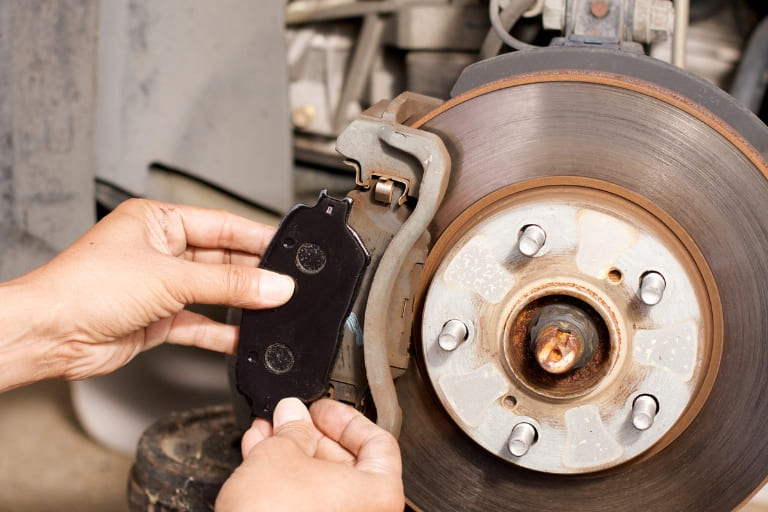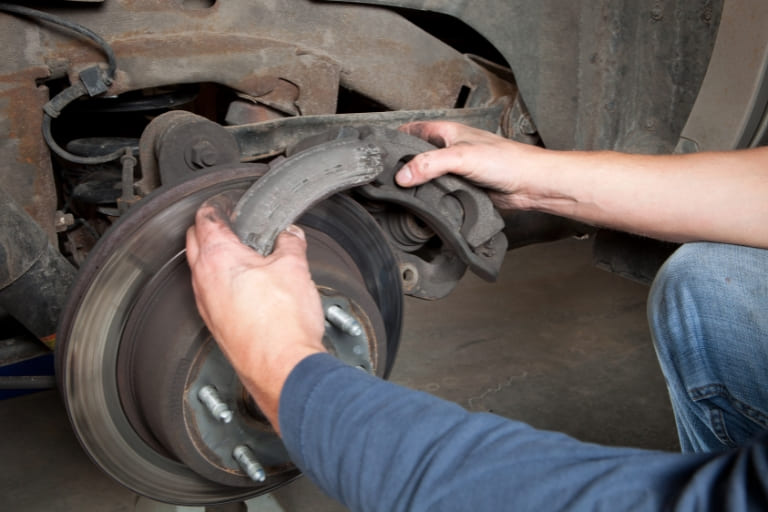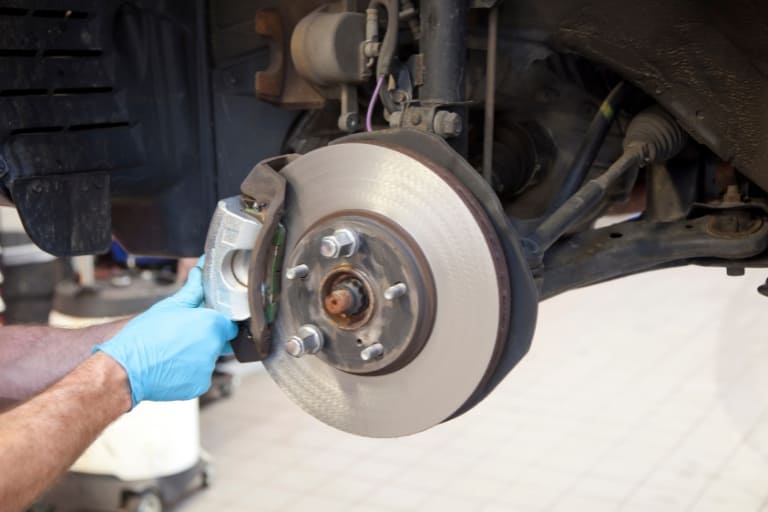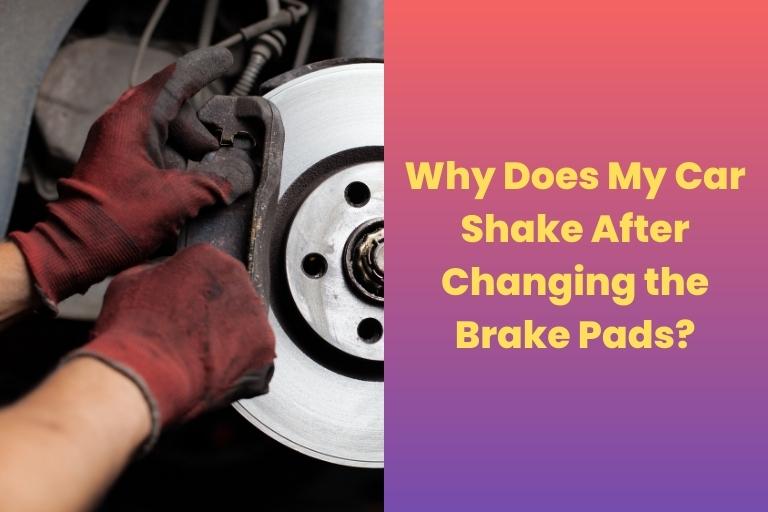You properly maintain your car and take it in for regular maintenance. However, after changing the brake pads, you discover that your car shakes. We understand your frustration. It’s an uncomfortable and dangerous situation. So it is critical to figure out what’s causing the issue.
When your car shakes following a brake pad change, it might be due to a number of issues, including tire, brake rotor, or suspension issues. The vibration may also indicate a major problem, such as worn or broken components that require rapid treatment.
In this article, we will look at the possible causes of your car shaking after a brake pad replacement, the risks involved with this problem, and how to deal with it successfully. By the end of this article, you will better understand what to do if you run into this issue and how to avoid it in the future.
Contents
- 1 Why does your car shake after changing the brake pads?
- 2 Potential reasons for your car shaking after changing the brake pads
- 3 How to Fix if Car Shakes after Changing the Brake Pads
- 4 How can regular brake system maintenance help prevent shaking after brake pad replacement?
- 5 Is it bad if my car shakes when I brake?
- 6 Frequently Asked Questions
- 7 Conclusion
Why does your car shake after changing the brake pads?
Your car may shake after changing the brake pads for various causes, including deformed brake rotors, worn-out suspension components, and faulty brake pad installation. These faults might result in unequal pressure distribution, which can generate vibrations compromising the car’s control and safety.
Potential reasons for your car shaking after changing the brake pads

There are various possible reasons why your automobile may shake after changing the brake pads.
Common causes include:
- Dirty Brake Rotors
- Warped Rotor from Factory
- Wheel Bearing Loose
- Dirty Hub or Flange
- Incorrectly Seated Brake Pads
- Loose Brake Caliper
- Brake Caliper Sticking
- Brake Fluid Leak
- Worn Suspension
Dirty brake rotors

After changing the brake pads, dirty brake rotors can cause the car to shake. Dirt, rust, and debris can build up on the surface of the rotors, generating uneven contact between the brake pads and the rotors and causing vibrations. In some situations, brake rotors can get glazed or overheated, worsening the problem.
Dirty brake rotors may be repaired by meticulously cleaning them, which can be done by a professional or yourself.
- To clean the brake rotors, your vehicle should be hoisted on jack stands and the wheels removed.
- Once the wheels have been removed, the mechanic or you yourself can use brake cleaner, sandpaper, or a wire brush to remove any dirt, rust, or debris from the rotor’s surface.
If the brake rotors are significantly damaged, deformed, or overheated, they may need to be resurfaced or replaced, necessitating a specialist’s assistance.
Resurfacing entails removing a tiny portion of the rotor’s surface to smooth it out, whereas replacement entails inserting new rotors. Repair costs vary based on the severity of the damage and the type of repair required, with replacement often costing more than resurfacing.
Ignoring filthy brake rotors can decrease braking performance, which can be hazardous and increase the likelihood of an accident. As a result, it’s critical to address the problem as soon as possible to ensure safe and pleasant driving.
Warped Rotor from Factory
A warped rotor happens when the rotor (the metal disc against which the brake pads press to slow the car) becomes uneven owing to overheating or uneven wear. When the brakes are engaged, the car may shake or tremble.
Here are some suggestions for repairing a warped brake rotor:
- Turn off your automobile and park it in a secure place.
- Take off the wheel cover and the tire from the rim.
- Place a piece of wood between the rotor and the hub to prevent damage to either item.
- Examine each blade for warping or bent edges.
- Replace the blade which you suspect for having bent edges.
Wheel Bearing Loose
A wheel bearing is a series of steel balls or rollers that hold the wheel in place and allow it to revolve smoothly on the axle. A loose or worn out wheel bearing can cause your automobile to tremor or wobble, especially at high speeds.
When a wheel bearing becomes loose, it causes the wheel to wobble and vibrate. This vibration is frequently felt in the steering wheel, making driving difficult. A loose wheel bearing can cause the wheel to fall off the vehicle severely, resulting in a difficult situation.
To repair a loose wheel bearing, follow these steps:
- Using a jack, raise the vehicle off the ground and secure it with jack stands.
- Remove the problematic wheel’s wheel and tire assembly.
- Remove the wheel hub assembly’s braking caliper and rotor.
- Remove the axle nut and washer from the axle shaft’s end.
- Remove the steering knuckle’s wheel hub assembly.
- Replace the old wheel bearing in the hub assembly with a new one.
- In reverse order, reassemble the wheel hub assembly, axle shaft, rotor, and brake caliper.
- To the manufacturer’s specifications, tighten the axle nut.
- If necessary, repeat the procedure for the remaining wheel bearings.
- Drive the car to confirm that the vibration is gone.
Dirty Hub or Flange
Before fitting the replacement rotor, the hub or flange against which the brake rotor is placed must be properly cleaned. Rust frequently accumulates on the flange. The rust gets disturbed when the old rotor is removed.
If the machined faces of the hub and rotor are not thoroughly cleaned, they will not sit flat with each other. Clean the hub with a wire brush or emery paper until it is smooth to the touch.
Incorrectly Seated Brake Pads
If the new brake pads are not correctly seated, the power supplied to the brake pedal and onto the caliper will be uneven. As a result, braking performance and shaking will deteriorate. This vibration is produced by incorrectly placed brake pads in the caliper.
Always keep your hands clean when installing brake pads. Make that the pads are evenly pushed on both sides of the rotor.
Loose Brake Caliper

A brake caliper is a disc braking system component that contains the brake pads and exerts pressure on them to slow or stop the vehicle. When a brake caliper is loose, the brake pads shake against the rotor, causing a visible vibration in the automobile.
Related Article: How Close Should Brake Pads Be To Rotors?
A sloppy brake caliper can also create uneven wear on the brake pads and rotor, shortening their lifespan and potentially resulting in brake failure. Resolving this issue as quickly as possible is critical to guarantee your and others’ safety on the road.
To repair a loose brake caliper, follow these steps:
- Carefully remove the brake caliper bolts.
- Examine the bolts and bolt holes on the spindle critically for rust or corrosion.
- Retread the bolt hole using a thread cleaner or chaser.
- Install the brake system.
- Ensure the recommended torque pressure when tightening the caliper bolts.
Brake Caliper Sticking
A squeaking brake caliper might create vibration in your vehicle. A brake caliper is a disc braking system component that contains the brake pads and exerts pressure on them to slow or stop the vehicle. When a brake caliper becomes stuck, the brake pads can scrape against the rotor, causing friction and heat. This can cause uneven wear on the brake pads and rotors, shortening their lifespan and causing the car to shake or pull to one side when braking.
You can fix a stuck brake caliper by doing the following:
- Using a jack, raise the vehicle off the ground and secure it with jack stands.
- Remove the problematic wheel’s wheel and tire assembly.
- Examine the brake caliper for damage or wear after removing it from the rotor.
- Examine the brake pads for uniform wear and thickness. Replace them with new ones if they are uneven or damaged.
- Inspect the caliper piston and guide pins for wear and damage. Replace them with new ones if they are broken or worn.
- Brake cleaner should be used to clean the caliper piston and guide pins completely.
- High-temperature brake oil should lubricate the caliper piston and guide pins.
- Replace the caliper on the rotor and tighten the mounting bolts according to the manufacturer’s instructions.
- Replace the wheel and tire assembly and return the vehicle to the ground.
- Drive the car to confirm that the vibration is gone.
Brake Fluid Leak
If the brake hoses are not examined after any brake replacement or repair, brake fluid might leak. When the brake pedal is depressed, fluid will escape, or air will be allowed in, causing shaking as the pads bounce off the rotor. While changing pads or rotors, expelling any air from the lines is a good idea.
Worn Suspension
A vehicle’s suspension system is in charge of maintaining stability and managing wheel movement. When the suspension system is worn, the automobile will tremble or shake, especially when accelerating, braking, or turning. Worn suspension components, such as shocks, struts, or bushings, can cause wheel misalignment or uneven tire wear, resulting in vibration or shaking.
Here’s a step-by-step way to resolve this problem:
- Before repairing or replacing the suspension system, it is critical to identify the exact problem. A competent technician can diagnose the issue by thoroughly inspecting the suspension system.
- Replace worn components: Once the problem has been identified, worn components such as shocks, struts, or bushings must be replaced. Because removing and installing suspension parts requires specialized tools and knowledge, this is a job best left to a professional mechanic.
- Inspect other suspension components: As the worn components are replaced, and the technician should inspect the complete suspension system to ensure that all components are in excellent working order.
- Verify wheel alignment: After replacing worn suspension components, it is critical to verify the wheel alignment. Even with new suspension components, mismatched wheels can cause the automobile to tremor or shake.
- Test drive: Drive the vehicle after the suspension system has been restored and the alignment has been verified to guarantee that the vibration or shaking has been remedied.
How to Fix if Car Shakes after Changing the Brake Pads
If your car shakes after changing the brake pads, it might be due to a number of factors, including poor installation or other braking system faults.
Here’s a step-by-step way to resolve this problem:
- Inspect the brake pads to verify they are properly placed and not loose. If they are loose, remove them and properly replace them.
- Examine the brake calipers and rotors for any signs of wear or warping. Replace them with new ones if they are broken or worn.
- Examine the brake hardware, including the clips and shims, to verify it is properly placed and not loose.
- Check the brake fluid level and, if required, fill it off.
- Bleed the brakes to remove any air from the system if the brake fluid level was low or the brake lines were opened during the brake pad replacement.
- Check the wheel bearings for any damage or wear. If they are damaged or worn, replace them with new ones.
- Check the suspension components, including the ball joints and tie rod ends, for any damage or wear. If they are damaged or worn, replace them with new ones.
- Check the tires for any damage, wear, or imbalance. If they are damaged or worn, replace them with new ones. If they are imbalanced, have them balanced at a tire shop.
- Take the vehicle for a test drive to ensure the shaking has been eliminated.
How can regular brake system maintenance help prevent shaking after brake pad replacement?
Regular brake system maintenance can help minimize shaking following brake pad replacement by ensuring all braking system components are in excellent operating condition. This involves examining the brake system for any urgent issues, such as frictional materials needing to be replaced or a comprehensive overhaul, from hoses and lines to drum brakes or disc brakes.
Regular maintenance also involves assessing system performance for adequate pressure, length of travel, and actuation reaction time, as well as checking for worn brake pads, rotors, calipers, drums, and hardware components. You may assist in minimizing shaking following brake pad replacement by keeping your braking system up to date and working efficiently.
Is it bad if my car shakes when I brake?
Yes. It is certainly cause for concern. While the problem is usually simple to resolve, it can be hazardous if left unattended. It impairs your ability to control your vehicle properly, and there is always the risk of the brakes seizing up or failing, which could result in an accident. Having a mechanic look it over as soon as possible is advisable.
Frequently Asked Questions
Can brake pads make your wheel shake?
Yes, brake pads can cause wheel vibration. If the brake pads are incorrectly placed, unevenly worn, or do not make complete contact with the rotor, vibration or shaking in the wheel might occur when braking. This can also cause uneven wear on the brake pads and rotor, lowering their lifespan and potentially triggering other braking system troubles. Brake pad installation and maintenance are critical to preventing wheel shake and ensuring safe and effective braking.
Why does my brake pedal vibrate when stopping
Several factors can contribute to a vibrating brake pedal, including worn or warped brake rotors, unevenly worn brake pads, or a stuck brake caliper. When you press the brake pedal, friction is created between the brake pads and the rotor, causing vibrations. It is critical to get the brake system evaluated by a competent technician to detect and repair the problem before it escalates to more serious issues with the braking system.
Can a bad brake caliper make your car shake?
Yes. A faulty brake caliper might cause your vehicle to wobble. A stuck or malfunctioning brake caliper can create uneven wear on the brake pads and rotor, resulting in vibrations or shaking in the car during braking. It is critical to get the braking system evaluated by a competent technician to detect and repair any faults with the brake caliper before they progress to more serious braking system problems.
Can using low-quality brake pads or rotors contribute to shaking after brake pad replacement?
Yes, Using low-quality brake pads or rotors might lead to shaking after replacing brake pads. Cheap, low-quality brake pads or rotors may be within manufacturer standards and may wear unevenly, resulting in vibrations when braking. To guarantee safe and effective braking and to avoid difficulties like shaking or vibrations following brake pad replacement, it’s critical to choose high-quality, dependable brake pads and rotors and have them put correctly.
You May Also Like to Read:
- Can You Spray Brake Cleaner On Brake Pads? Does It Help?
- Are Brake Pads Interchangeable? Let’s Find Out
- Does The Emergency Brake Lock All Wheels?
- Do Ceramic Brake Pads Contain Asbestos?
- Can You Use Front Brake Pads On The Rear?
- How to Install Anti-Rattle Clips on Brake Pads
- How Long Can You Drive Without Brake Pads?
- How Long Do Brake Pads Last
- Fixing New Ceramic Brake Pads Making a Grinding Noise
- Ceramic vs. Semi-Metallic Brake Pads: Which is Better?
- Why Are My Brakes Grinding After New Pads And Rotors
- Ceramic vs OEM brake pads
- Ceramic vs Organic Brake Pads: In-depth Comparison
- Ceramic vs Carbon Fiber Brake Pads: A Comprehensive Comparison
Conclusion
In conclusion, experiencing vibrations or shaking in your car after replacing brake pads can indicate underlying braking system issues. Warped rotors, loose brake calipers, stuck calipers, and low-quality brake pads or rotors can all contribute to this issue. To maintain safe and efficient braking and to avoid future damage to the brake system, it is critical to detect and repair these faults as soon as possible.
Routine braking system maintenance and inspections, as well as the use of high-quality, dependable brake pads and rotors, can help minimize concerns like shaking or vibrations while braking.
If you need help with diagnosing or repairing brake problems, it is advisable to get expert help from a trained mechanic or repair shop. Your braking system will perform properly and give you the safe and dependable stopping power you want for your everyday driving demands if it is properly maintained and cared for.
